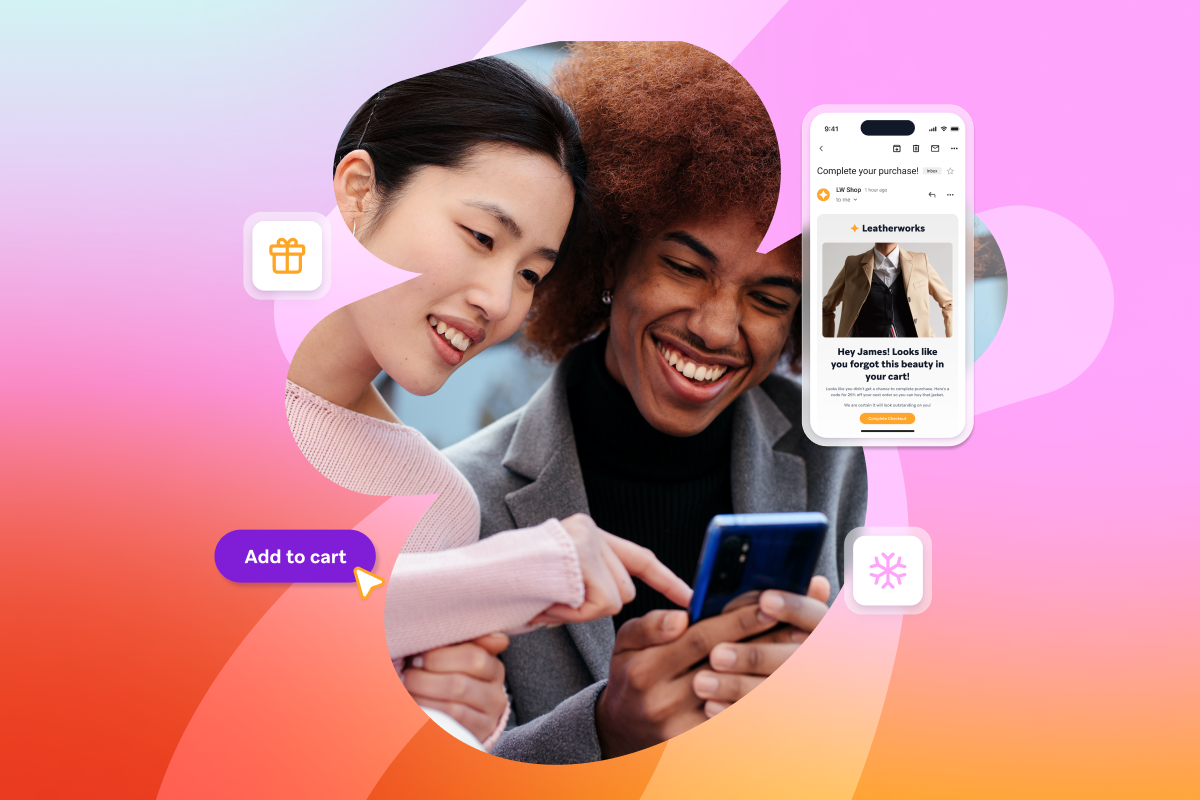The Evolution of Push Notifications: 15 Years of Expansion and Innovation
Published on November 25, 2024/Last edited on November 25, 2024/7 min read


Team Braze
Push notifications have evolved considerably over the last 15 years since making their first appearance in 2009. They’re no longer just for mobile devices, they’re for web, wearables, smart TVs, and even VR, AR, and spatial computing. They’re also no longer static text-based messages that get sent out as batch-and-blast campaigns. Today, the most effective push notifications are rich, dynamic, personalized, and optimized in real time.
The Evolution of Push, from 2009 to Today
The Launch of Push Notifications and Early Push Notification Use Cases
Turn on the time circuits, and we’ll return to 2009. Avatar is smashing box office records, The Black Eyed Peas are climbing the charts, and Apple has launched APNs (Apple Push Notification System) for iOS apps. Sure, Blackberry has been sending out email notifications since 2003 (earning it the nickname “Crackberry”), but the iOS 3.0 update is different. It finally brings push notifications out of the email space and into a new era of cross-channel messaging.
Borrowing from the BlackBerry playbook, Apple has users reaching for their phones when they hear that “ping.” Although these generic, text-based messages may not look like much, they offer the first opportunity for mobile engagement campaigns.
Android users will have to wait until 2010 for Google to launch C2DM (Cloud-to-Device Messaging), but there’s no doubt that push is going mainstream.
It soon becomes clear that mobile apps are helpful for understanding customer behavior. Brands start experimenting with segment-level personalization and send out messages based on customer behavior. New campaigns are built around event-based messages, such as:
The Debut of Location Targeting
Remember when your phone’s GPS drained your battery in minutes? Those days are over. The latest smartphones have improved their technology, allowing you to match your search results to your exact location—without sacrificing battery life.
This is great news for brands as location-based marketing creates even more opportunities for push notifications. Retailers can send messages to remind customers about store credit when they’re nearby, and travel brands can send booking information when customers reach their destinations. Brands are now able to send messages at the right time and to the right place.
Rich Push Notifications, Push Action Buttons, and Push Stories
Let’s jump ahead to 2012. Push notifications have been limited to text…until now. With the release of Android 4.1, Android users can now receive upgraded push notifications featuring images and push action buttons. Rich media images make push more visually appealing, while push action buttons allow for personalized calls-to-action that give users a range of different actions they can initiate directly within the notification without having to open an app, such as sharing an article or bookmarking it, making a purchase, or leaving a review.
While iPhone users end up having to wait a few years, with the eventual release of iOS 10 in 2016, Apple expands rich push capabilities to include GIFs, audio, and video.
Another big change in 2016: Both Apple and Android announce support for carousel or multi-image push, also known as Push Stories.
There’s no doubt about it, push notifications have matured from simple alerts to vehicles for information, making them less like SMS and more like social media
Wearables Push Notifications and Web Push Notifications
At the same time as mobile push is progressing to become more multifaceted, in parallel two new push channels are emerging: wearables push notifications and web push notifications.
In March 2014, Google reveals the coming of Android Wear, the company’s new operating system for smartwatches that will include support for wearable notifications users can view and engage with on their wrists. Months later in September, Apple introduces the Apple Watch, which arrives in 2015 and makes Apple fans even more connected to their favorite apps.
In December 2014, Google became the first browser to add support for web push notifications. This messaging channel makes it possible for marketers to engage web users even when they’re not actively visiting their websites. Over the next few years, Mozilla, Apple, and Microsoft follow suit.
As push makes the leap from mobile to the web and smartwatches, true cross-device push campaigns become a reality.
Live Activities

The next big shakeup in the world of mobile and tablet push notifications arrives in 2022, with the debut of Apple’s Live Activities. These are real-time persistent messages that appear right on iPhone and iPad lock screens without users having to unlock their devices, giving brands a new highly visible way to share up-to-the-minute information.
Instead of having to send multiple push notifications about a given event or transaction, marketers can now keep users updated dynamically, such as:
- During a countdown to the premiere of a new episode of a user’s favorite show
- In the lead-up to the departure of a traveler’s upcoming flight or hotel stay
- When a package ships, is in transit, and is delivered
AR, VR, and Spatial Computing Push Notifications

In February 2024, Apple’s first-ever 3D camera Vision Pro becomes available for purchase. With its arrival and the introduction of its companion operating system, visionOS, push as we’ve known it enters a whole new frontier.
Building on earlier virtual reality (VR) and augmented reality (AR) technologies, this new spatial computing platform gives brands with iOS apps the chance to extend their digital experiences beyond two-dimensional mobile interactions into the realm of three-dimensional experiences.
In May 2024, Braze announces support for creating push notification campaigns (as well as in-app messages and Content Cards) for Vision Pro users.
As with any new digital platform, marketers will now have to think about how to best use spatial computing to best engage their customers to drive stronger relationships.
The Here and Now: Push Becomes More Privacy-Focused
Starting in 2021 and progressing through to today, new changes are introduced that reshape the push messaging landscape with a privacy-first focus.
With the release of iOS 15 in September 2021, new Focus Modes give users the ability to determine which apps can send notifications during modes like Work, Sleep, Personal, and more, to reduce potential distractions and gain better control over their notifications, which in turn can lower push open rates.

With the release of Android 13 in 2022, Android follows Apple’s lead and now requires apps to get user consent before they can send the users push notifications. Given this change, push primers are an important tool that brands should use to educate users about the benefits of opting into receiving push notifications, such as immediately after a user completes a high-value action within the company’s app.

Fast forward to 2024, and once again Android follows Apple in giving users more control over the messages they receive with new updates coming with the launch of Android 15. This time, Android is expanding on their Do Not Disturb rules. Previously, users could block notifications during certain times, but now they’ll be able to further customize these preferences, a move that’s likely to impact Android open rates.
Also in 2024, both Android and Apple announce new privacy features. In May 2024, Android reveals that new Private Spaces will be coming later in the year, giving users the option to store sensitive apps in a separate space with a separate user profile. These can be locked and when they’re locked, notifications will be hidden, which could end up impacting opens and engagement. In June 2024, Apple makes a similar announcement, revealing that iPhone and iPad users will be able to lock and hide apps on their devices and when these apps are hidden, notifications from these apps will not be visible, which again could impact opens and engagement.
Where is push headed?
In the next 15 years, we anticipate that push notifications will continue to expand across new platforms and devices, including gaming systems. The trend of empowering users with greater control over their push experiences is set to continue, which means brands must proactively seek user consent and preferences regarding content and timing. As demonstrated by Live Activities, push messaging is increasingly shifting towards “moments-based'” communication, delivering relevant messages right when users need them. To stay ahead, brands should explore innovative ways to ensure their messaging aligns seamlessly with each user's unique context.
Key takeaway
As these new changes go into effect and other shifts emerge, to remain competitive in today’s landscape, brands must lean into sending notifications that are as engaging, personalized, interactive, relevant, and as secure as possible.
Related Tags
Releated Content
View the Blog
The Evolution of Push Notifications: 15 Years of Expansion and Innovation

Team Braze

Holiday Email Deliverability: Tips and Tricks from Braze Experts

Team Braze

Destination Inbox: Navigating the Modern Landscape of Email Deliverability
